Ferriers – a Bures house and its connection to the Mayflower.
WITCHES, WAMPUMS AND A VERY SPECIAL RELATIONSHIP.
From the Great Migration to Plymouth Colony’s First Lady, the Salem Witch Trials and even the spoils of ‘King Philip’s War’, all have been linked directly to Ferriers and its C17th owners, the Waldegrave and Pelham families.
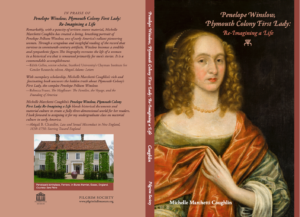 Two books charting the roles of these families in founding New England have recently been published: Rebecca Fraser’s ‘The Mayflower Generation’ and Michelle Marchetti Coughlin’s ‘Penelope Pelham Winslow: Plymouth Colony First Lady’. Meanwhile, a documentary funded by the British Arts Council seeks to solve the enduring mystery of the missing Wampum Belts of the highly influential Wampanoag Chief Metacomet, known to the settlers as King Philip.
Two books charting the roles of these families in founding New England have recently been published: Rebecca Fraser’s ‘The Mayflower Generation’ and Michelle Marchetti Coughlin’s ‘Penelope Pelham Winslow: Plymouth Colony First Lady’. Meanwhile, a documentary funded by the British Arts Council seeks to solve the enduring mystery of the missing Wampum Belts of the highly influential Wampanoag Chief Metacomet, known to the settlers as King Philip.
Such were the significance of these royal symbols that Plymouth Colony Governor Josiah Winslow decided to present them to King Charles II as a ‘trophy’ of the wars against the indigenous Americans and their safe delivery was entrusted to his brother-in-law Waldegrave Pelham. The belts, however, never made it to Charles II with the last known location being Ferriers…
Early History of Ferriers
Edward II (1284-1327) sat on the throne when the earliest reference was made to property at Ferriers. It was then held by the Earl of Derby, John de Ferrers, who gave the estate its name. Ferriers subsequently passed through John’s daughter to the Lords of Attleburgh, later held by the Cresseners of Hawkendon from 1411-1546 before being acquired by Anthony Waldegrave, the second son of Sir William Waldegrave of nearby Smallbridge Hall. The present Ferriers House, which sits just a few metres from the earlier manorial barn, dates from Anthony’s time with both properties passing via his son Thomas to Jemima Waldegrave, who married Herbert Pelham in 1626.
As part of a thriving and affluent Bures community in the 1630s, Ferriers was part of a much larger and grander estate owned by the Waldegraves, comprising the exquisite (and still-standing) fifteenth-century Great Bevills and Smallbridge Hall, as well as Ravensfield Farm, Peyton Hall, and Bures Mill.1
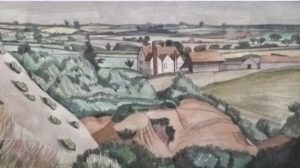
Ferriers by John Nash, 1964.
The manorial court on the Ferriers property was used by the lord to settle civil cases with his tenants. It has been described by distinguished local historian Leigh Alston as, “undoubtedly the finest and most complete example yet found.” Alston has compared it to Widdington Priory near Saffron Walden, noting that at 45 feet long and 20 wide, the court hall produces “a remarkable impression of space.” Lit by diamond mullion windows with sliding wooden shutters, it includes a separate chamber and private staircase for the lord at one end and an external staircase for the tenants opposite.
The Great Migration
This grand setting at Ferriers was where Herbert Pelham, ‘a formidable and wily figure’, 2 first proposed his plans to travel with his wife, Jemima, four young children and entire household to the New World. He called an open meeting at which, as the wealthy lord of the manor, he offered to pay the passage of any Bures residents who wanted to join him on the voyage; and in August 1638 this varied collection ‘of good quality and estate’,3 together with indentured servants, livestock, provisions and their ‘beautiful and elaborate household objects’,4 landed at Salem, Massachusetts as part of the Great Migration of 1620–1640, before settling in Cambridge MA. Jemima Waldegrave Pelham appears to have died before or on the voyage.
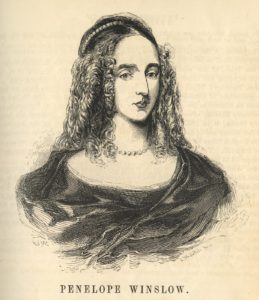
Penelope Winslow (nee Pelham) born at Ferriers and baptised at Bures Church in 1633
In truth, this was less of a voyage into the unknown for Herbert Pelham than for most of the Bures contingent. He was already a significant landowner in Massachusetts, having been one of the early investors, known as the ‘Merchant Adventurers’, in Massachusetts Bay Colony – to quote the excellent Rebecca Fraser, ‘he was now putting his money where his mouth was and…going to take up residence on his land in New England’. As an ardent supporter of Oliver Cromwell’s Parliamentary Party and a strong upholder of Puritan teachings, he was naturally inclined to the philosophy of the early settlers. Several were friends and relatives – perhaps most notably his kinsman, Mayflower passenger and Plymouth governor Edward Winslow. A regular visitor to Ferriers in the 1640s, Edward and fellow Mayflower passenger William Bradford were considered the two most important first settlers, as they were the authors who created the ‘Pilgrim narrative’. 5 Herbert’s brother William, one of the first planters at Sudbury, was also established in New England – as was his sister, Penelope, who married one of the most famous Governors of Massachusetts, Governor Richard Bellingham.6 Herbert was also related to many important colonising families, such as the De La Warrs.
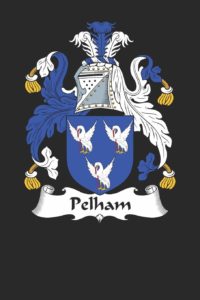
The Pelham Coat of Arms
These powerful family ties were further enhanced when Herbert’s daughter, Penelope, married Edward Winslow’s son Josiah, who himself would become governor of Plymouth Colony. With her gentry background (her third-great grandmother was Anne Boleyn’s sister, Mary7) and position as Plymouth’s ‘First Lady,’ Penelope was one of the colony’s most influential women as well as an extraordinary individual in her own right.8
The Salem Witch Trials
Given Herbert’s financial advantages, family connections, and undoubted intellect, it is no surprise that he was soon established as a leading settler of Massachusetts. He was even appointed to the highly prestigious position of Harvard College’s first treasurer. Owning four homes and around 1,000 acres of land, he was among Cambridge MA’s wealthiest inhabitants, ‘perhaps even the most wealthy’.9 The 400 acre ‘Pelham Island’ in Cambridge, MA, still bears his name.
Less fortunate were some of Herbert’s fellow travellers from Bures. The village, and the Essex-Suffolk borders more generally, were at the time renowned for ‘witchcraft’ largely due to the activities of the self-appointed ‘Witchfinder General’ Matthew Hopkins, who lived in nearby Manningtree. The arrival of a group of immigrants from Bures apparently stoked an existing fear of the supernatural, ultimately feeding into the mass hysteria which led to one of early Massachusetts’s most notorious episodes, the infamous and brutal ‘Salem Witch Trials’ of 1692 and 1693.
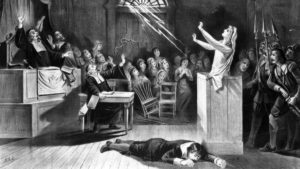
Salem Witch Trials 1692-1693
In 1932 an American psychiatrist Percy R. Vessie published a paper about New England witches in which he linked the Bures settlers directly with the introduction of Huntingdon’s disease to the United States; according to this theory the symptoms endured by the Bures families, involuntary jerks and ticks brought on by the disorder, were the reason they were labelled as ‘possessed by the devil’. This now disputed thesis10 gained sufficient credence for it to form the basis of the 1988 novel, The House of Stairs by local author, Barbara Vine – a.k.a Ruth Rendell, Baroness Rendell of Babergh.
Brooks Corwin, was stepmother to one of the most persistent judges, Jonathan Corwin, whose house in Salem still stands, operating as a museum called the ‘Witch House’. Penelope Pelham Winslow had a further intriguing link to the Salem Witch Trials – her sister-in-law, Elizabeth Winslow.

The Apotropaic ‘Sooty Graffiti’ on original 17C plaster Eave at Ferriers
Whatever the truth, a direct link between Bures and the ‘Salem Witch Trials’ is well-established and indeed visually represented in some seventeenth-century markings on the plaster of an attic eave at Ferriers. These rare surviving apotropaic symbols, used to ward off witchcraft, were burnt with soot from a candle onto the plaster and comprise a series of letters and numbers. Easiest to decipher is the ‘VV’ signifying the ‘Virgin of Virgins,’ Mary. In a curious coincidence, apotropaic markings are also found at the house built by Penelope Pelham Winslow’s son, where she spent her final years.
The Wampum Belts
Despite being an illustrious and successful figure amongst the early settlers, matters of estate at Ferriers brought him back to England in 1646, along with his children (with the exception of Penelope) and his second wife, Elizabeth Bossevile Harlakenden, widow of Roger Harlakenden of Colne Priory, Earls Colne.
After resettling at Ferriers, Herbert took on a slew of important civic roles, including representing Essex in Cromwell’s Puritan Parliament. Upon his death in 1674, the house passed to his eldest son, Waldegrave. In 1677, Waldegrave was entrusted by his brother-in-law, Governor Josiah Winslow, with the prestigious task of delivering to King Charles II ‘the highly symbolic war trophies of King Philip’s regalia’ 11 in the form of the elaborate wampum belts ‘which had once adorned Philip’s now decapitated and pathetic body’.12 According to a letter sent by Governor Josiah Winslow to King Charles II on June 26th, 1677, these belts were ‘wrought with black and white wampum in figures and flowers, and pictures of many birds and beasts’.13

C18th image of Philip, King of Mount Hope, in full royal regalia including Wampum Belts
Waldegrave, however, appears to have defaulted on his mission, as the belts were never delivered: ‘Entrusting this task to Waldegrave Pelham was a mistake. Josiah’s ne’er-do-well brother-in-law never delivered the famous regalia of the Wampanoag chieftains. It vanished and has not been seen again’.14
The last known location is believed to have been at Ferriers: ‘where Philip’s belt lies today remains a mystery. Perhaps, they are buried in the ground near the old Pelham Manor in Essex’ 15– certainly the Pelhams were accustomed to conducting burials at Ferriers, with the graves of Herbert’s daughter, Jemima, and other family members said to lie by the small pond in view of the house.
The significance of the Wampum Belts is underlined by the US Government’s continued lobbying of its British counterparts for their return (most recently resulting in John Major’s government instigating an unsuccessful search).
But perhaps we will shortly see a breakthrough in the mystery. The story of the belts and the question of their whereabouts is the subject of a forthcoming documentary by Wampanoag scholar Paula Peters, funded in part by the British Arts Council. Moreover an exhibition Peters has worked on entitled ‘Wampum: Stories from the Shells of Native America,’ which includes a replica, is due to tour the UK in 2021 (postponed from 2020).
Ferriers Today
The importance of Ferriers is not restricted to its role and influence in the founding of New England. As William Geoffrey Probert states in his fascinating History of Bures, this Manor has been “so closely and for so many centuries connected with [the history of] Bures”. Certainly the manorial court would have been a prominent focal point for Bures village life over the centuries.
Another local historian, Alan Beales, has added considerably to the depth of knowledge about Ferriers and its broader history on the ever-illuminating Bures website. 16 As Alan points out, the current owners themselves have historic ties to Ferriers. Jemima Waldegrave Pelham’s cousin, Mary Waldegrave, married current owner Hugh Petre’s direct antecedent, John, the 1st Baron Petre, in 1570. With the Waldegraves and Petres both part of the Essex Catholic gentry of the time, there were likely regular visits between the Waldegraves at Ferriers and Lord and Lady Petre at the family seats at Writtle Park and Thorndon Hall.
It is deeply encouraging that the critical importance of protecting and preserving these heritage sites has been recognised in the new guide for Heritage in Neighbourhood Plans, published by the National Trust which places great emphasis on ‘identifying and safeguarding local heritage’ and through the development of a local plan ‘communities …have an opportunity to create a vision for the future…agreeing what is special and how local character and heritage can be preserved’. 17
It is difficult to overstate the importance of organisations such as the Dedham Vale Society (DVS) and the Dedham Vale AONB & Stour Valley Project (the Project) in campaigning to ensure these guidelines are upheld. Heritage buildings possess enormous historic value through their correlation with the important events that occurred within and around them, such as the religious, social and political upheavals described in this article – they represent the history and culture of our local area and need the protection of National and Local Authorities encouraged by these and similar amenity organisations.
If you are interested in the 400th Anniversary Celebrations of the Mayflower, essential further reading includes:
- Rebecca Fraser’s book ‘The Mayflower Generation’ – a Times History Book of the Year is available from Waterstones, Amazon and all good book shops
- Michelle Marchetti Coughlin book ‘Penelope Winslow, Plymouth Colony First Lady: Re-Imagining a Life’.
- www.mayflower400uk.org
Editor’s Note
In 2019 an application was made to develop the dilapidated C20th farm buildings adjoining Ferriers, including one building less than 6 metres from the grade 2 listed manorial barn, into three 5-bed executive-style rental properties, entirely inappropriate to the historic setting in the countryside. The Colne Stour Countryside Association (CSCA) formed part of a local, national and international effort objecting to the proposed development, highlighting the unique historic importance of Ferriers and the impact the development would have on the proposed extension of the Dedham Vale AONB. As the inspector recorded in his judgement rejecting the Gladman application for 98 houses off the Colchester road “the landscape around Bures, is not ordinary countryside of no value but is of high sensitivity and is locally valued”. The support of CSCA and many others has, for the time being, led to the withdrawal of the application – although we understand that a new and virtually identical application is imminent, so please watch this space:
1 https://colnestour.org/magazine_article/bures-mill-nine-centuries/
2 ‘The Mayflower Generation’ by Rebecca Fraser
3 As above
4 As above
5 BBC Radio 4, Sunday 29.12.19; ‘The Mayflower – 400 Years’
6 Governor Richard Bellingham was in 1628 the MP for Boston, Lincolnshire in the UK prior to Charles I 1629 dismissal of Parliament.
7 Painted in 1651 along with Penelope’s husband Josiah and father-in-law Edward, this trio of paintings forms one of the earliest sets of American colonial family portraits
8 Mary Boleyn was the subject of Philippa Gregory’s historical novel, ‘The Other Boleyn Girl’ subsequently made into the 2008 hit film of the same name
9 https://www.youtube.com/watch?v=P6Hma82wzYE – Michelle’s lecture about Penelope, including references to Bures, Smallbridge, Bevills and Ferriers
10 ‘The Mayflower Generation’ by Rebecca Fraser
12 ‘King Philip’s War: The History and Legacy of America’s Forgotten Conflict’ by Eric B. Schultz and Michael J. Tougias
13 As above
14 This letter is now held in the National Archives at Kew
15 As above
16 As above
18 https://nt.global.ssl.fastly.net/documents/neighbourhood-planning-and-heritage-guidance.pdf
